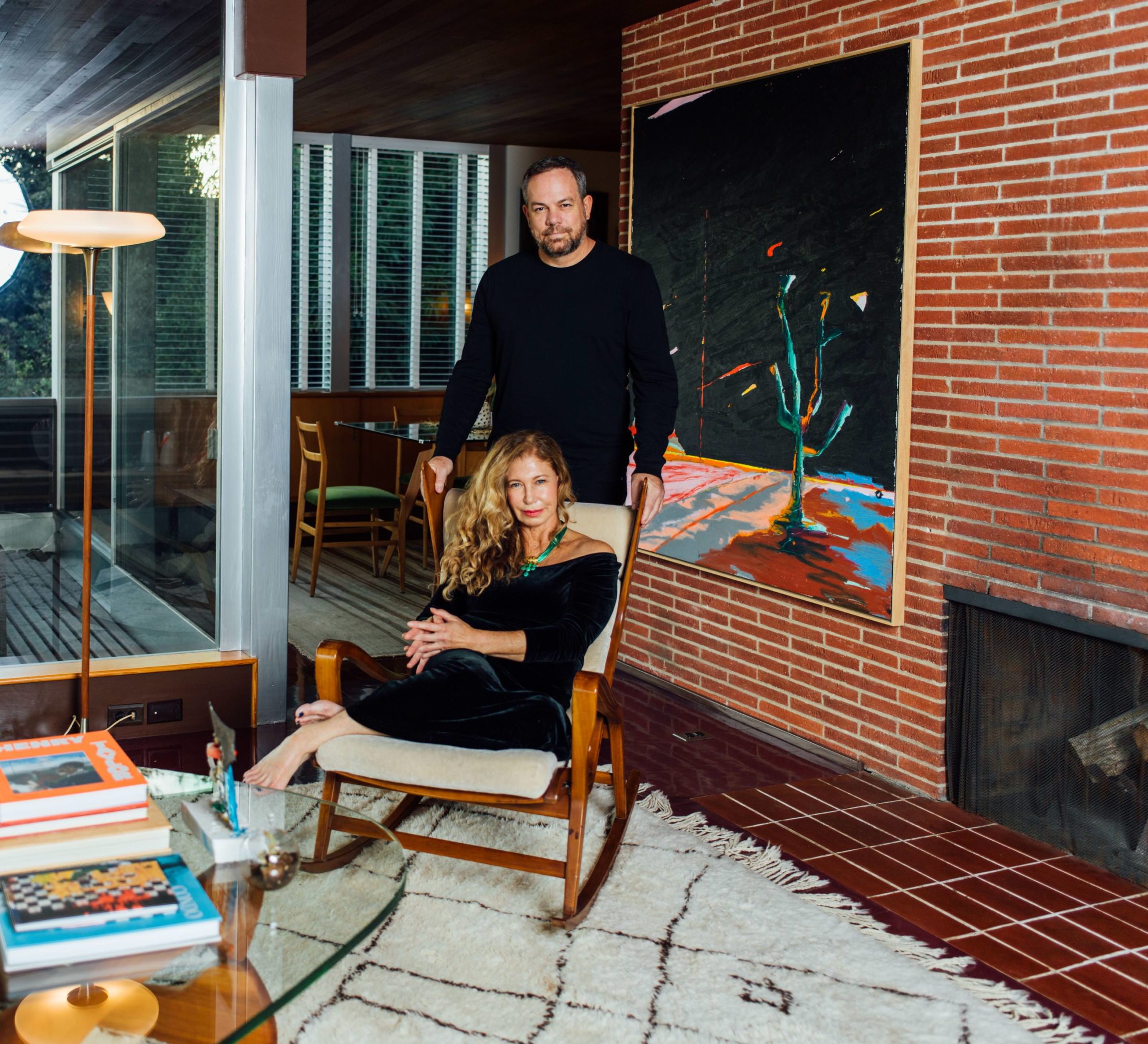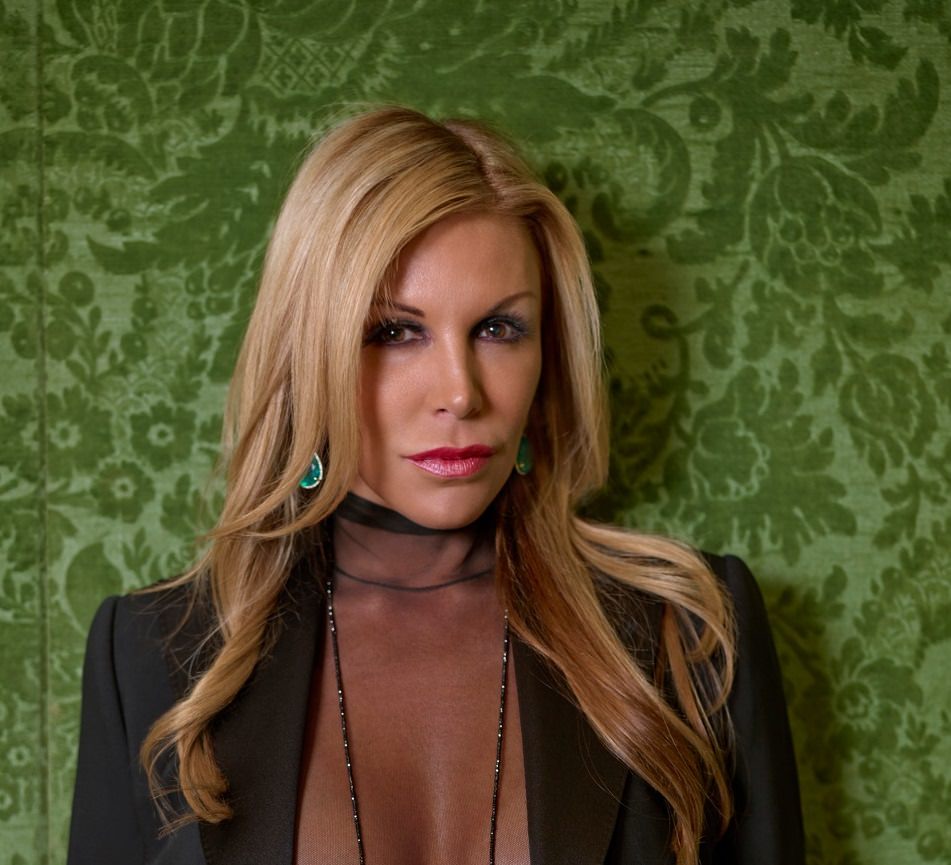An extraordinary array of works by the Brazilian artist Adriana Varejão are on view at Gagosian in Los Angeles until October 25. An illusionist with a flair for the Baroque, Varejão gives form to our fetish for finish. Los Angeles, then, is the tailor-made location for “Interiors,” her first-ever West Coast show. Several series of works are on display: the “big tile” Monochrome paintings; Charques, Varejão’s meaty painted wall and floorreliefs; and the Sauna paintings of tiled and vacant interiors.
“Interiors” by Adriana Varejão
“Interiors” is Gagosian’s contribution to Pacific Standard Time: LA/LA (the abbreviation is for “Latin American / Los Angeles”). Underwritten by the Getty, this year’s Pacific Standard Time has 70 institutions across Southern California spotlighting Latin American and Latino art. While a fear-mongering U.S. president pushes a border wall and scapegoats immigrants, we need to take a historically informed stance on border relations. Transcultural initiatives like Pacific Standard Time: LA/LA and vanguard Latin American artists like Adriana Varejão bring public focus to the ways in which we are indebted to mixture and to fluid borders.
 Adriana Varejão, portrait by Vicente de Mello.
Adriana Varejão, portrait by Vicente de Mello.
Despite its instant visual impact, Varejão’s body of work will have you mulling over art’s relationship with social history. I sent her some highfalutin questions. She fired answers back. Did she think painting was dead? “Painting is a body that agonizes yet doesn’t die,” she replied. Like all forms of expression, painting can be used to defend the status quo. Certain artists, like Varejao, use it to shake things up.
Details of Adriana Varejão’s Work
If you flip through a catalogue of Varejão’s works, you’ll see a lot of agonized flesh. It’s a Baroque metaphor turned on its head. Something abstract (art’s entanglement in a history of human cruelty) becomes a visual effect. She fabricates a fleshy interior, which seethes and breaks through uniform surfaces (a Minimalist grid, monochromatic tiles, or a canvas) that are also signs for art-world honesty (à la Frank Stella’s “What you see is what you see”). Varejão mixes and mashes trademark styles, dramatizing visual tricks, making historical characters appear anachronistically modern and vice versa. The strange double-standard of art (it serves as both the false face and the visual proof of cultural imperialism) would take anyone a book and footnotes to explain. Varejão gets it across by shattering a blank canvas with trompe l’oeil cracks.
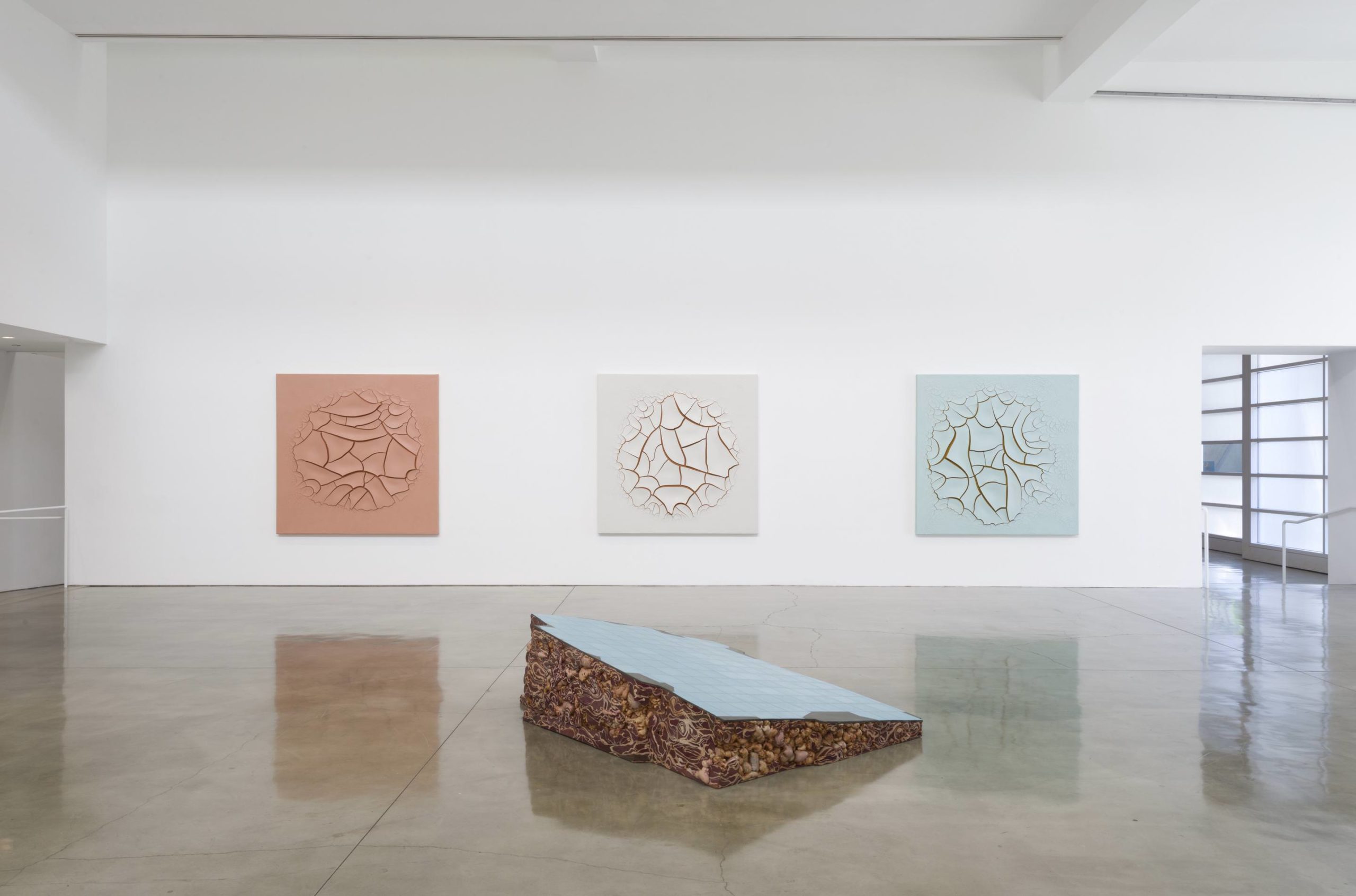 Exhibition view of Adriana Varejão’s “Interiors” at Gagosian in Los Angeles (September 14—October 25).
Exhibition view of Adriana Varejão’s “Interiors” at Gagosian in Los Angeles (September 14—October 25).
You can tell Varejão reads, and reads a lot (she weaves Gilles Deleuze and Gilberto Freyre into our conversation). But rather than playing the role of a nerdyspecialist with her names and dates, though, she’s got an appropriative jouissance that’s characteristic of the Brazilian modernist movement. By mimicking the charms and fouls of bygone art in a painstakingly roundabout way, she brings to light art’s subterfuge. Some of her works are blown-up interpretations of the blue-and-white, hand-painted tiles that are to be found all over Brazil (covering secular and religious buildings alike). These innocent-seeming tiles, however, have a complex provenance. They’re the vestiges of Brazil’s colonial past with delicate designs that are inflected by centuries of colonial trade and conquest between the Islamic world, China, Holland, Spain, and Portugal. Varejão’s body of work exhumes these out-of-mind and out-of-sight relationships, absorbing the shock and awe of our colonial past, along with its butterfly effects. In the case of Varejão, what you see is never all that you can see.
Adriana Varejão Shares Insight on “Interiors”
WHITEWALL: What do you think people mean when they say painting is a dead art?
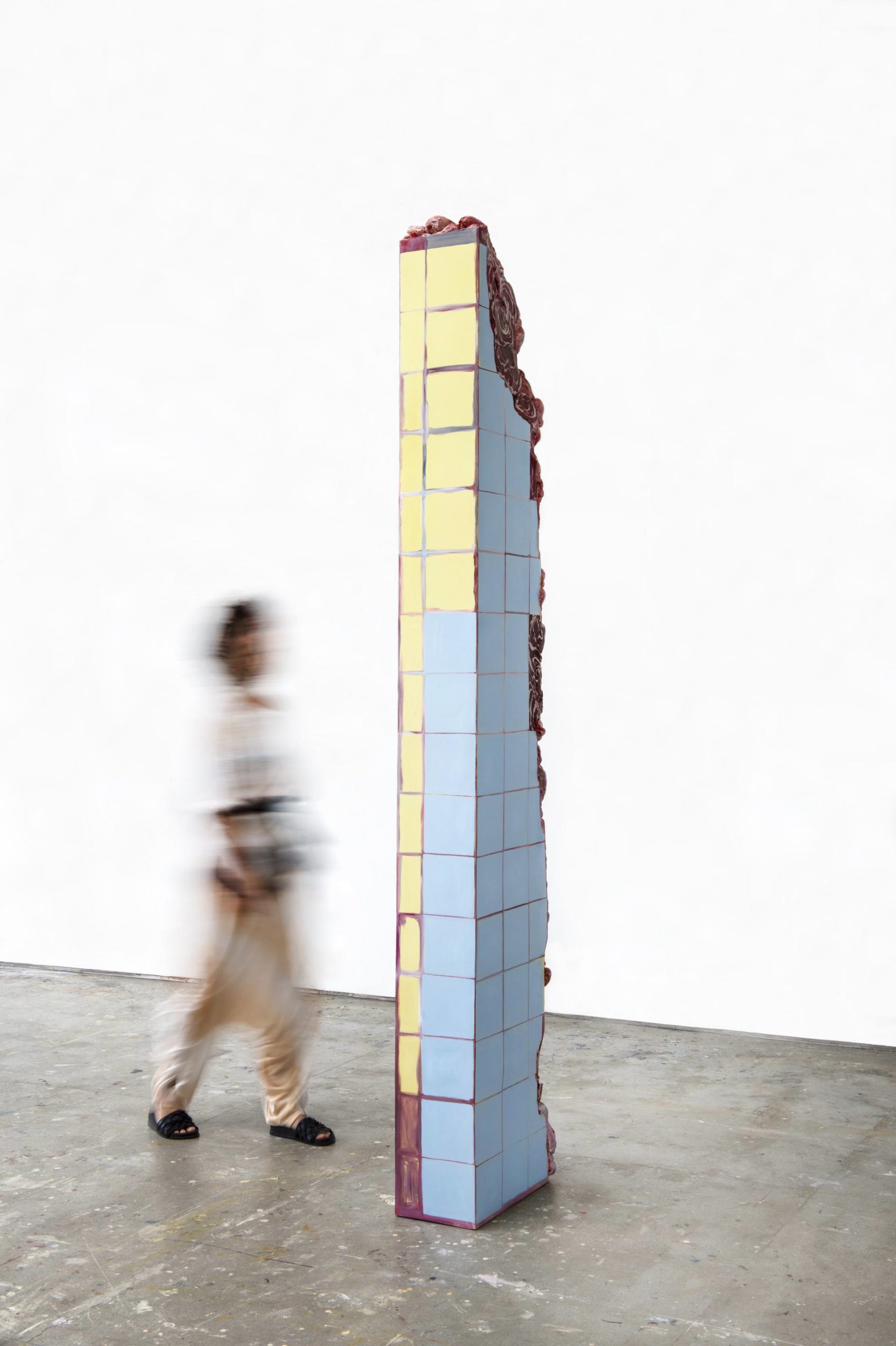 Adriana Varejão
Adriana Varejão Rome Meat Ruin
2016
Oil on aluminum and polyurethane
256 x 46 x 26 cm
Courtesy of the artist and Gagosian
ADRIANA VAREJÃO: First of all, I love to think of painting as a dead woman, as Ophelia who floats in the dark waters and drowns in her own weight. This image is fantastic. Imagining painting as that woman inspires me to paint. The 20th century saw the development of many, many other media in art, and so now and then painting is thought of as old-fashioned. But painting is a body that agonizes yet doesn’t die; it continues to exist, passionately and vigorously. But in the end it doesn’t make much sense to talk about medium; we should, rather, talk about content. And content never dies.
WW: How do you maneuver the institutional pitfalls of the art world and its labels? Through what terms would you like your art to be encountered?
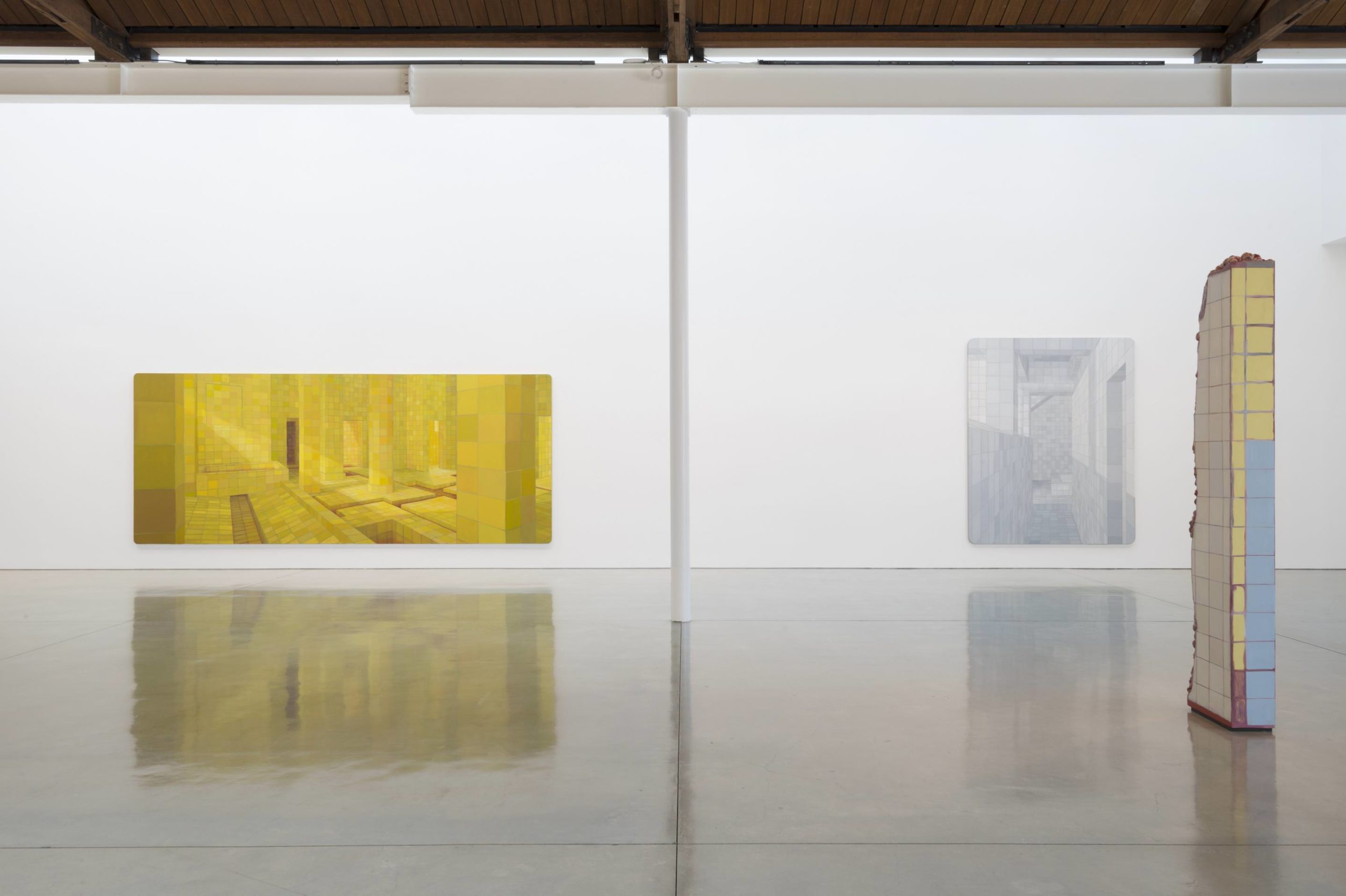 Exhibition view of Adriana Varejão’s “Interiors” at Gagosian in Los Angeles (September 14—October 25).
Exhibition view of Adriana Varejão’s “Interiors” at Gagosian in Los Angeles (September 14—October 25).
AV: I adapt myself. For me what matters is not nationality or gender; the focus is on quality and content. I would like that my art affect viewers; I would like to be understood as a tropical Baroque artist. Since Brazil is formed by a wide cultural mix of Indigenous Brazilians, Africans, and Europeans, and East Asians, the Baroque in Central and South America is a Baroque mestizo, which absorbs elements of the local culture. My philosophy has been formulated upon this historical reality. In addition, modernism in Brazil is based on the concept of cultural anthropophagy (Oswald de Andrade), which is very important to us. Brazil, as a colonized country, rather than imitating the dominant culture, has swallowed it, incorporated it, producing new elements. That’s why I refer to the Baroque so often, because the Latin-American Baroque has this characteristic power of cultural absorption. In this way, Brazilian culture never feels threatened by external influences, only enriched by them. It is at the same time local, original, and universal.
WW: You confront the violent legacy of colonialism and of cultural imperialism. In a way, these exploitative forces fast-tracked the cultural hybridity that threatens conservatives today. What can art teach us about hybridity? And about “pure” origins?
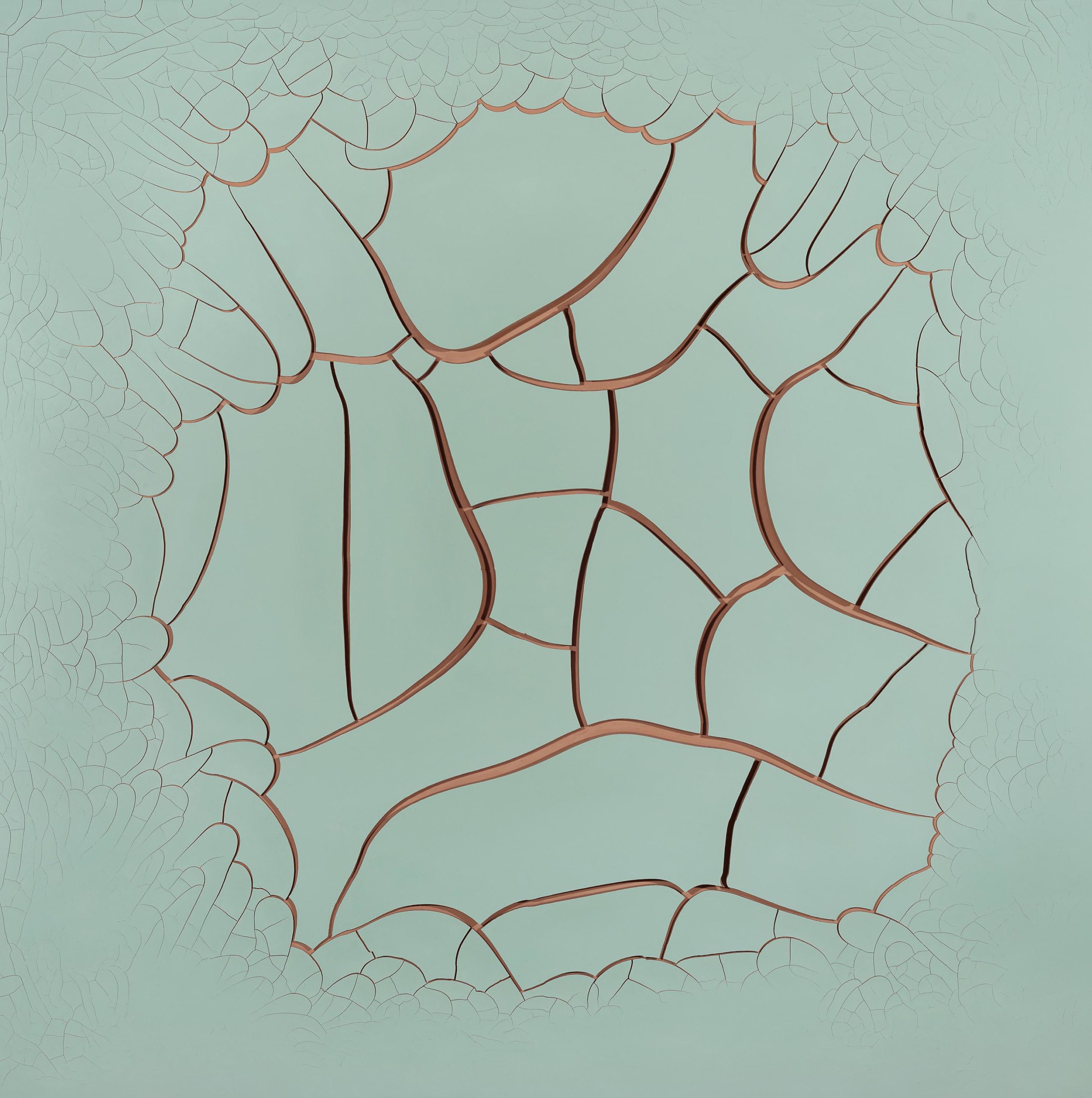 Adriana Varejão
Adriana Varejão Green Song – LA
2017
Oil and plaster on canvas
180 x 180cm
Courtesy of the artist and Gagosian
AV: My work is always in the territory of hybridity. All of my content is built in a sense of decolonizing subjectivities, because it deals with countless cultural references, not only from official history, but from many other hidden or obscured histories that lie at the margins. It’s very effective because the visual arts bring a wide power of synthesis to the subject. For example, in the “Terra Incognita” series there is a cultural hybridism that creates an imaginary cultural continuity between Brazil and China, two cultural and geographical extremes. Or the “Polvo” oil paintings that exemplify that the racial issue goes beyond the simple dichotomy of black and white.
A Relationship with Truth
WW: A creative blurring of fact and fiction is often abused (I’m thinking of Donald Trump here). What is your own relationship to “truth”? Should we maintain our belief in truth?
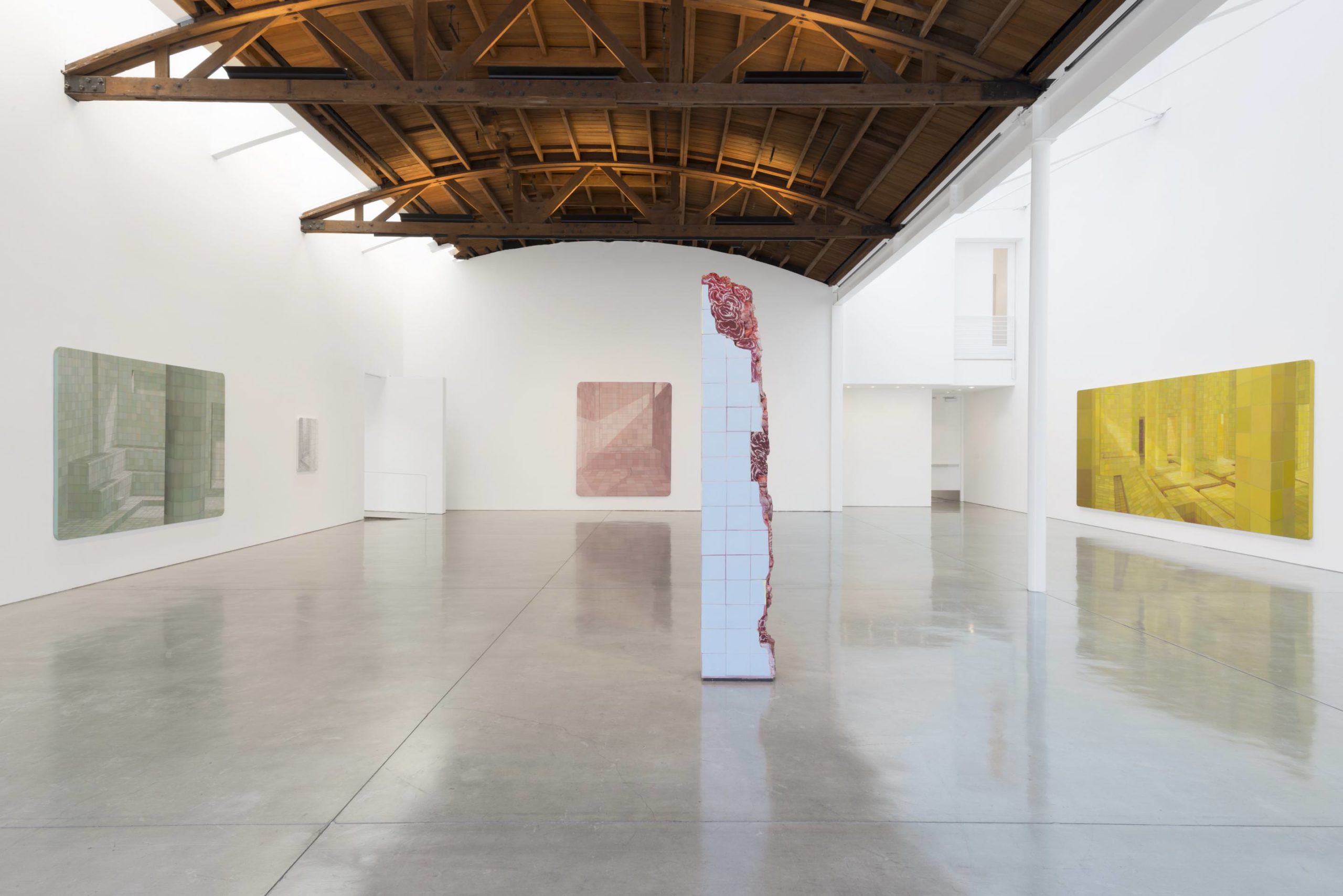 Exhibition view of Adriana Varejão’s “Interiors” at Gagosian in Los Angeles (September 14—October 25).
Exhibition view of Adriana Varejão’s “Interiors” at Gagosian in Los Angeles (September 14—October 25).
AV: In relation to journalistic language, truth is compromised by facts. But in the poetic field, the real issue is not about facts; the truth of poetry is an emotional truth. It is not compromised by facts; the only truth of poetry is language, to affect the emotions and the senses. Artists (and poets) are like earthworms; our function is to breathe air into language, to rescue it from the aridity of the quotidian world.
WW: Tell me about your archive of images. How do photographs prompt your painterly imagination?
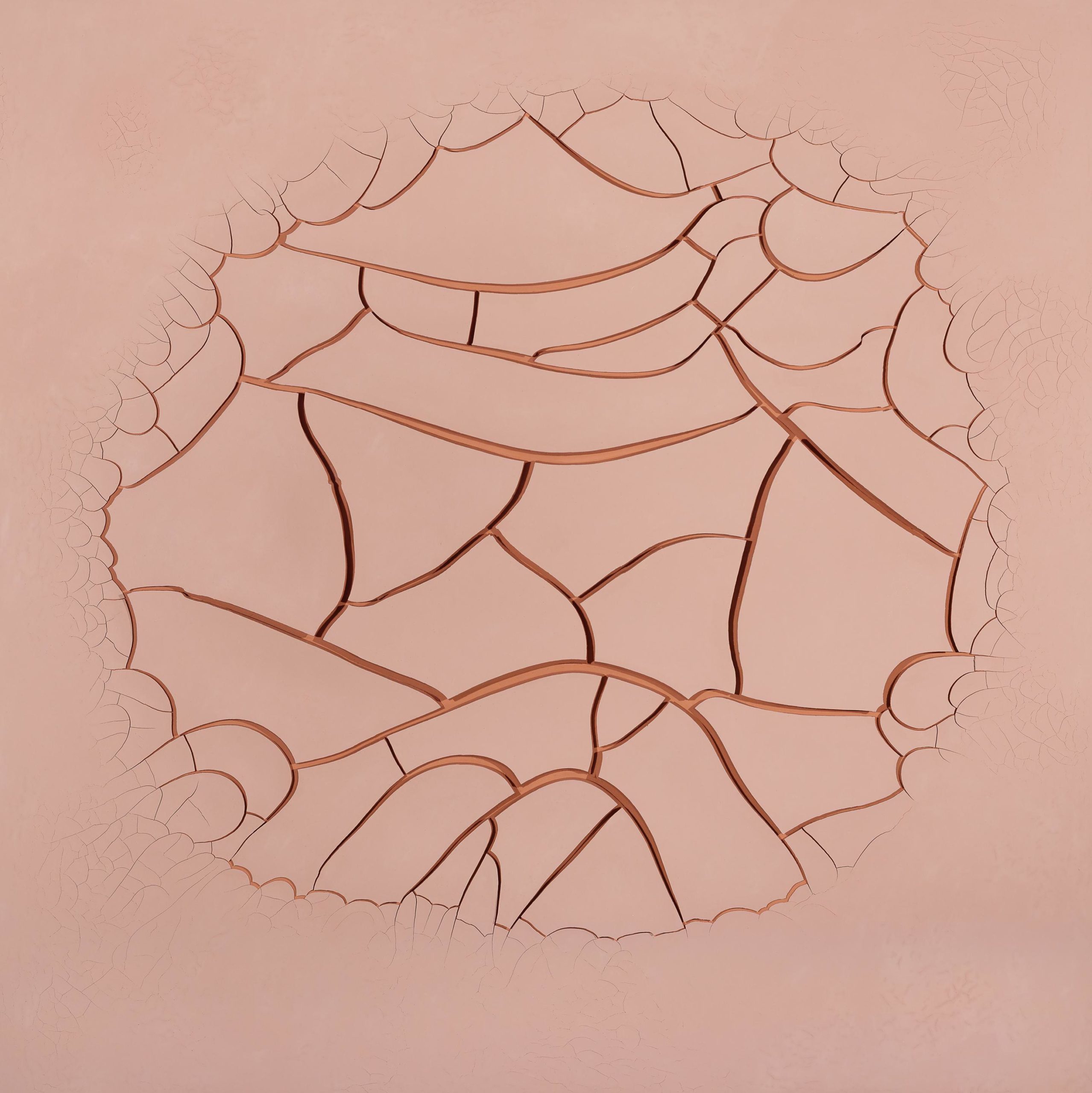 Adriana Varejão
Adriana Varejão Rose Song – LA
2017
Oil and plaster on canvas
180 x 180cm
Courtesy of the artist and Gagosian
AV: I work with many forms of iconography and reference. Normally, I make research that can inspire me with regard to a certain subject. Sometimes, as with the Baroque blue-and-white tiles, I create my own archive of images that I photograph myself on my travels—of buildings, churches, and museums around the world, especially in Brazil and Portugal. I use them as references. In these buildings with their huge decorative panels composed of thousands of tiles, I look for, and edit, a unique and individual tile, or a small fragment, that has the potential for me to alter it and subsequently increase its scale by one hundred times so as to transform it in a painting—an “Azulejão” (Big Tile) painting. I work more with parody than quotation, in the sense that I usually recontextualize the images that I have taken as references.
Technology’s Evolution
WW: Thanks to the Internet, everyone has access to the sights and sounds of faraway places. What are your thoughts on technology? How has it changed your experience of time and space?
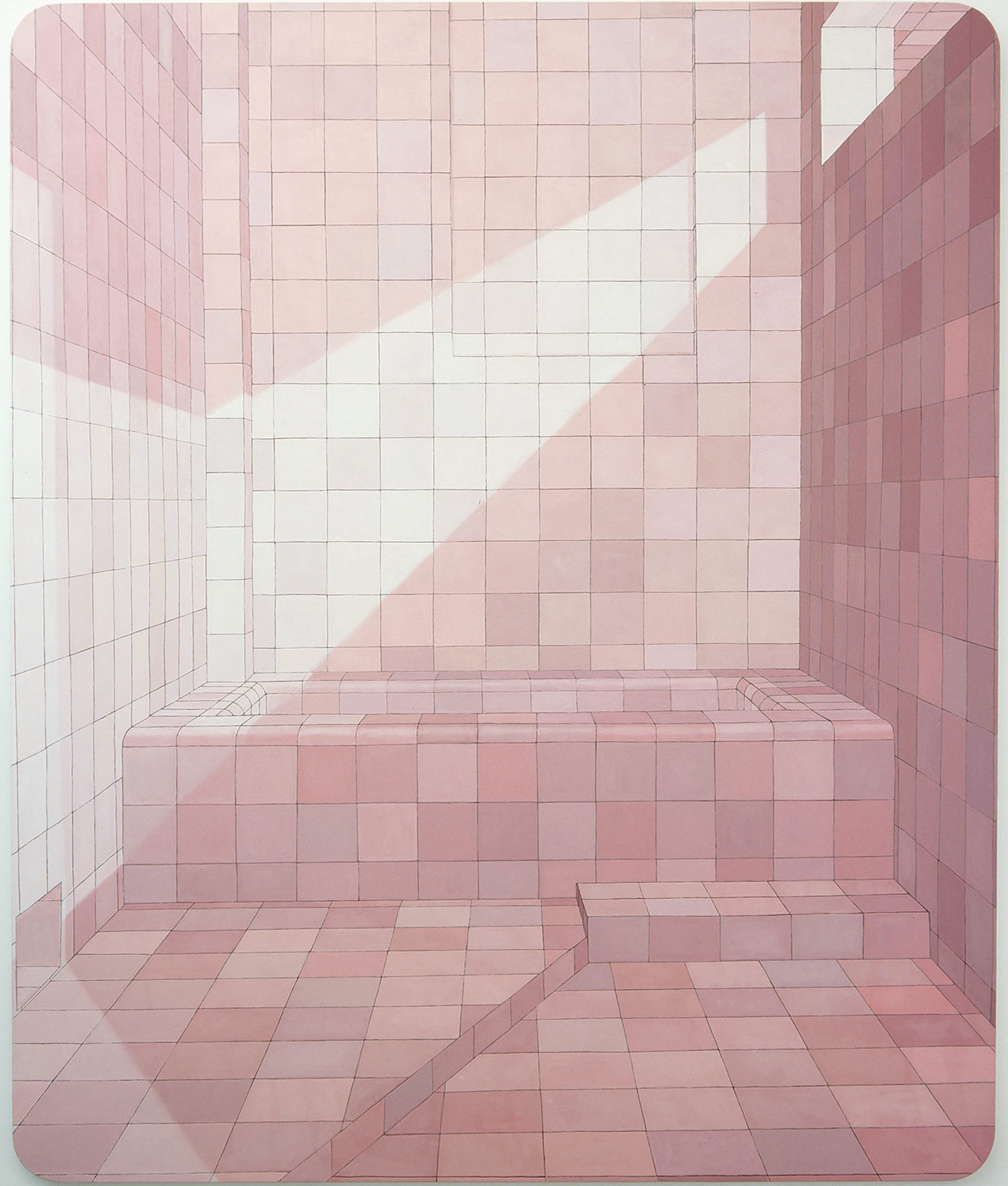 Adriana Varejão
Adriana Varejão A diva (The Diva)
20014
Oil on canvas
265 x 220 cm
Courtesy of the artist and Gagosian
AV: I think technology is a wonderful thing. For the first time humanity can communicate in a global level; hidden voices can be heard. Technology has transposed geographical barriers. When I started to paint, my references were mainly my books and my travels, visiting archives and museums. Nowadays, my research and references are much richer because I can access a multiplicity of information.
WW: Why “Interiors” for the title of your Gagosian show?
AV: We chose this title for the exhibition thinking mainly about the “Sauna” paintings. There is a figure that Deleuze describes in his book Leibniz and the Baroque, which is the “monad,” a structure that is pure interior and produces its own light. The monad is a recurrent idea in Baroque architecture, a fission between exterior and interior. In a way, I identify the saunas as a sort of ambience that is pure interior, with no windows, no trace of the outside. On the other hand, there are many other works in the exhibition that deal with the idea of breaking the surface; with skin; with searching for what lies beyond or within a surface. In architecture, the interior is the counterpoint to the facade; in the architecture of the body, this relationship is between skin and meat. In the video installation Transbarroco I show four types of interiors in Baroque churches, which I used many times as references for my works—one covered with gold, one with tiles, one with very strong Chinese references, and one that is an Aleijadinho church painted by Athaíde, artists who were both famous mestizos and whose mestizo mentality is reflected in the interior paintings.
A First Show in Los Angeles
WW: Vija Celmins, whom you mentioned in a past interview, was based in L.A. during her early career. Like you, she uses “artifice to strip artifice of artifice.” Los Angeles is an industry town that fabricates: a place of dramatic contrasts, where the line between fiction and reality is creatively blurred.
AV: I am excited to show my work for the very first time in Los Angeles, especially in the context of this year’s Pacific Standard Time, with its focus on Latin American and Latino art, and also in terms of the vibrant local art scene. However, in my limited experience of the city itself, I would perhaps describe its artifice and excess as Rococo rather than Baroque.
WW: Can you tell me more about Transbarroco? What was your experience of making a video and using sound?
AV: Transbarroco was shot with a very elaborate production apparatus. It was great to go directly to the sources and references, because usually I don’t reveal them in the work. We traveled to different sites in Brazil where the Baroque flourished in the 17th and 18th centuries: Minas Gerais, Rio de Janeiro, and Bahia. With the camera, we were able to zoom in on these sites to capture intimate details, which was how I had seen them, from very close. With the soundtrack, I could make a collage of many other references, such as the voices of informal local guides of the churches, with their strong local accents and very particular ways of telling stories; music influenced by African rhythms; church bells; the writer José Eduardo Agualusa reciting a passage from Gilberto Freyre’s book Masters and Slaves, which recounts the influence of the language of black nannies on the white children they raised, how they softened the children’s language and made the words more tender and playful.
WW: A sauna is both an intensely public and private space: democratic as well as exclusionary. What drew you to the motif?
AV: The saunas also refer to a project of cleanliness and order. In my work, I have made extensive use of Baroque decorative tile work, filled with voluptuousness, desire, and violence. With the saunas, the tiles are quiet and aseptic; initially, their objective is to erase the dirty, the imperfect, folds, fat, furrows . . . all excess. The saunas are, therefore, a counterpoint to the Baroque decorative tile work. But one must also remember that a sauna can be a place of promiscuity and transgressive sensuality, as opposed to the utopian project of purity. Thus, in the saunas, one loses the illusion that its colors were once pure; after all, even the junctions between the tiles might be filled with filth and impurities, and the folds contaminated.
WW: Does art have any responsibility to the viewer?
AV: Art is amoral; it is the only proposition that you can answer with a question. And to ask a question is never offensive, so I don’t think that art should be concerned with responsibility!
WW: Philosophically speaking, what lies behind the white canvas?
AV: My paintings always deal with layers. For me, the white canvas is a pregnant belly. Fontana cuts the canvas to break the possibility of illusionism. I feel the opposite. When I cut the canvas, I reveal the representation of a body, which is beneath it.
WW: What is “the mestizo mind”?
AV: It’s a mind that doesn’t have predefined conceptions, that is open to the exterior and that doesn’t feel threatened by any culture or element that is different to it. It simply absorbs and transforms as its own. A mestizo mind is very similar to the concept of cultural anthropophagy.








